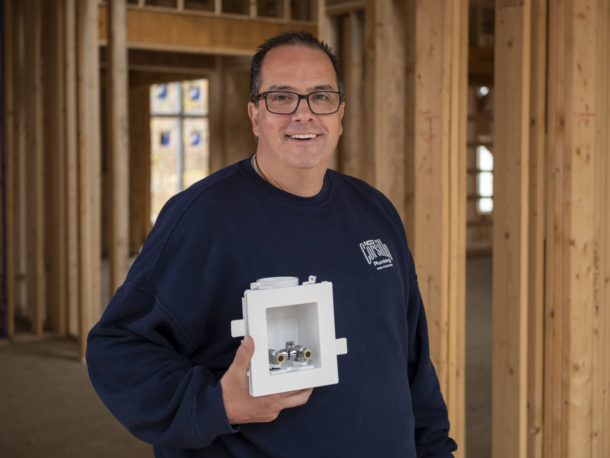Mike Corsillo, a Ohio new-construction plumbing contractor, keys his success on rigorous planning, organization, and offering builders and consumers the “latest and greatest” for their homes. MODA Supply Boxes have proven a perfect fit with those business values.
Third-generation plumber Mike Corsillo has a background familiar to many professional plumbers: tagging along with his dad to jobsites as a kid, thinking what fun it was to be at work with him. These good memories cemented his career choice – joining his father and brother at Corsillo Plumbing & Sewer Cleaning. In 1998, he launched the New Construction Division (NCD) of the family business.
However, after many years as one company, Mike set out on his own in 2004. He established NCD Corsillo Plumbing in suburban Cleveland. The name, of course, pays homage to his family’s history and his own future in the plumbing business. In 2020, Corsillo’s company will install plumbing in well over 200 new homes — despite the pandemic — while also handling about 30 to 40 remodels. With 22 employees and 14 trucks, Corsillo’s trading area extends roughly 80 miles from the headquarters office in Chardon.

In the following interview with Corsillo, we explore what it takes for a plumber to successfully meet the needs of home-builder clients in the highly competitive new-construction market.
Question: Why new construction versus other types of plumbing work?
Mike Corsillo (MC):I really like the opportunity to engineer the jobs ourselves. Working in residential construction for 14 different builders, we do not receive a plumbing print. The builder will show us where the plumbing fixtures go, but how we get there — the size and layout of the piping — is done by us in the field. That part of the work always intrigued me, figuring stuff out.
Q: What are the keys to success in your type of plumbing work?
MC: Planning, organizing and scheduling. If you need to get to a particular destination, you don’t just get into your car and start driving. Likewise, before you go to pipe a home, you must have a plan. We are well-organized, making sure our crews have the materials and equipment they need when they need them, and that they are scheduled accordingly.
By “scheduling,” I don’t mean we meet every deadline; rather, we know how long it will take for us to complete a certain type of job. We forecast to our builders when we will finish. If a job is supposed to start on Monday, and I cannot get there, I can tell him our people will be there on Wednesday, and they know what we say is true.
I know my parameters, so I can be flexible in moving our schedule around.
Q: What slows you down on a job?
MC: We work with lots of variables: weather, other trades late to the job, delayed product orders, etc. We try to stay ahead of all that. For example, we schedule out two months, and order all our materials that far in advance.
We have also gone to iPads in the field so my guys have all their blueprints and other key documents on pads. Anything we get on paper, I digitize to consolidate information in one place — cabinet layouts, appliances, locations of the gas line and sanitary lines, etc. I mark up those digital documents, so everyone sees the same thing at the same time. This enables us to be much more consistent in our work. We always try to stay ahead, stay innovative, in an effort to save time and money, while improving our organization.
We made the digital leap five years ago, and it has made a big difference in our productivity and accuracy. The builders we work with, both national and local, share many of the same values about planning and organization. Instead of taking on builders at random, I try to match our organization with builders who believe in the same values we do, so they will actually listen to what I have to offer to help their companies.
At the end of the day, our company is just an extension of that home builder. His success is my success.
Q: What was your reaction to Oatey’s MODA Supply Box System when it was first introduced to you by Oatey rep Matt Decaprio of Preferred Sales?
MC: Initially I was a bit skeptical, but then Matt shared a case study on how the product delivered labor savings for the contractor on a big Nashville hotel. I read that story and there were a lot of similarities in how we calculate costs. So, I thought, “Maybe it would be a good fit for us, dollar-wise.”
As I do with any case study I read, I plugged in my own numbers and at the end of the day, I saw that the product saves time. But there were other considerations as well.
All those pieces and parts on a job can get lost or broken. The MODA Supply Box is a single unit that eliminates components and is a one-time installation, reducing the likelihood that something will get lost on the job site. It makes it very easy. We always looking for ways to streamline our materials, and this product aligned with that goal.
Q: How have your crews worked traditionally with this type of application?
MC: We used a bracket system, consisting of a metal bracket and a plastic 90-degree elbow that would receive our PEX into the bracket. At the rough-in stage, we would stub hot- and cold-water lines out of the wall in PEX, and then cap each line. Then we would test the line. During the finish stage, we would cut off the cap and then install a flange, a stop and a supply line to the sink.
The MODA Supply Box eliminates all those pieces except for the supply line. As a result, during the rough-in stage, we are doing not only the rough-in, but also part of the finish. It is all condensed into the single supply box, and there is no wasted material, which used to be the case when I had to cut off the cap.
Meanwhile, all those other components are no longer needed. All I need is the supply line that connects the faucet to the valve inside the box, which also contains a flange.
Q: Have you found other benefits with the MODA Supply Box?
MC: I’m a bigger guy, and it used to be a lot of “fun” squeezing myself inside some of these cabinets and vanities. With MODA eliminating cutting and capping lines, a mechanic simply hooks the supply line to the box. The installation is quicker and easier, we save money, and we’re not beating up our guys, either. Any time I can make the job easier by reducing the wear-and-tear, it boosts productivity.
MODA also finishes much more nicely for the builder and the homeowner by providing a cleaner, more consistent look on a project.
Q: Are there any other features that you like, especially in comparison with the old methods?
MC: I was pleasantly surprised and very impressed with the heavy-duty construction of the box itself, as well as how easily the valve can be replaced if you do have a bad valve. It is a high-quality product, and I am impressed with it just as I am with all Oatey products.
Q: What kind of savings are you achieving in time and dollars?
MC: We save approximately 15 to 20 minutes on each unit, while we pay only $5 more for the MODA Box than what we paid for all those now-unnecessary components combined. So, we are seeing a savings of approximately $20 per supply box, including both the rough-in and the finish.
Each home we do uses eight to 24 boxes — the latter figure for some of the larger, custom homes we currently do. Eight is the average. We buy in bulk, again to save money, and they come in a crate of 12, and our guys are bringing back three to four boxes from each crate.
That might not seem a huge amount of money, $20 per box, but let me tell you it certainly is. In today’s market, prices area always rising, but it’s not like I can run to the builder for a concession to cover all those increases. As a result, any savings we can achieve is a total bonus, helping us to offset the constant fluctuation in commodity prices. Eight MODA boxes per house times $20 per box equals a savings of $160 per home. In a neighborhood of 200 homes, that adds up to a very nice savings.
Q: The MODA Supply Box seems a pretty good fit with the way you plumb homes.
MC: To date, we have done 15 homes with the product, and we plan to continue using it. We always want to separate ourselves from the competition at least a little. And we want the customer to know they are getting the latest and greatest products in their new home. Just like cell phones: No matter what you have, the new one always seems better. We are trying to do that with plumbing products.
When we see a product that can help us promote a new home, make it different in the eyes of the buyer than the guy’s home next door, it’s a win for us and the builder.




Join the conversation: